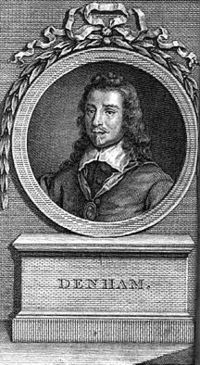John Denham (poet)
He married firstly, in 1634, Ann Cotton, of a wealthy Gloucestershire family, by whom he had three children, a son who died young and two daughters who reached adulthood.
In his earlier years, Denham suffered for his Royalism; during the English Civil War, he was appointed High Sheriff of Surrey (for 1642) and governor of Farnham Castle.
He spent the next five years in Oxford, where he enjoyed the trust and confidence of Charles I During the abortive peace negotiations of 1646, Parliament listed him as one of those who must be excluded from the King's counsels.
John Webb, who, as Inigo Jones's deputy undoubtedly had the competence to have served in the post, complained that "though Mr. Denham may, as most gentry, have some knowledge of the theory of architecture, he can have none of the practice and must employ another".
Denham in 1665 made an unhappy second marriage to Margaret Brooke, a beautiful young woman almost thirty years his junior, who conducted a very public affair with the future King James II.
In any case, rumour named several other possible poisoners, including James, his wife Anne Hyde and his sister-in-law, Lady Rochester.
He had long been rumoured to be insane, a condition generally attributed to his scandalous marriage, and later the hostility of the London public, which regarded him as a murderer, and he became a virtual recluse.
It is the first example in English of a poem devoted to local description, picturing the Thames Valley scenery around his home at Egham in Surrey.
"[9] He also received extravagant praise from Samuel Johnson, who quoted Denham's verse to exemplify the use of several words;[10] but the place now assigned to him is more humble.

